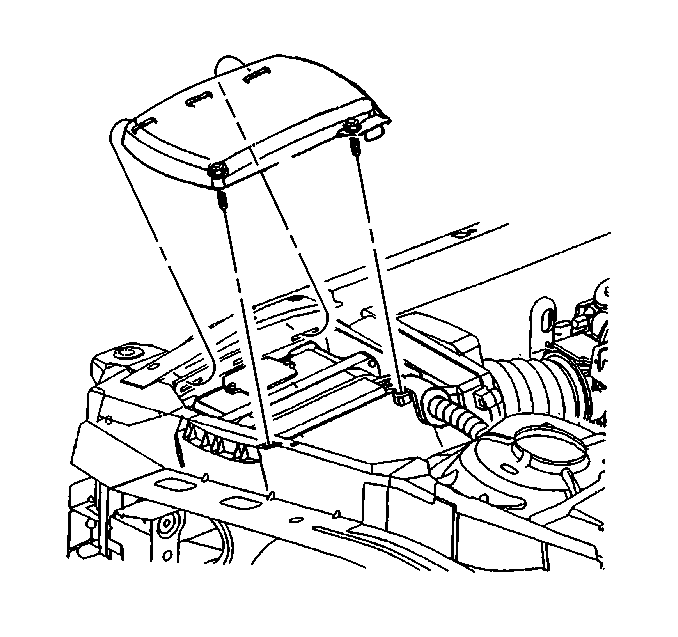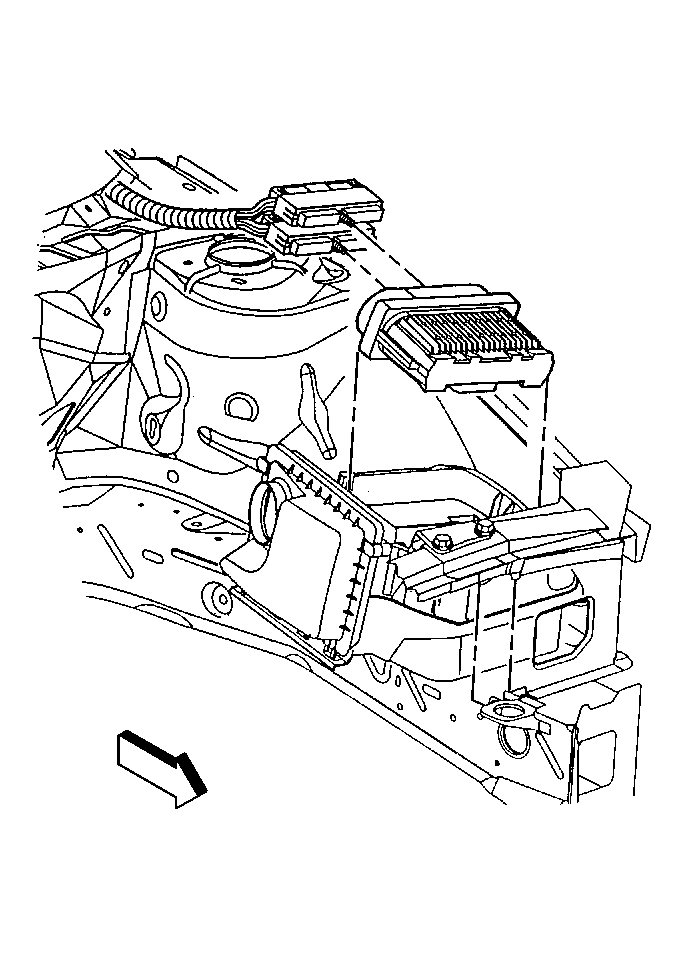Powertrain Control Module Replacement/Programming PCM Service
Service of the PCM normally consists of PCM replacement or PCM reprogramming.
If the diagnostic procedures call for PCM replacement, check the PCM first to see
if it is the correct part. If the PCM is malfunctioning, remove it and install the
new service PCM.
The new service PCM will not be programmed. You must program the new PCM. DTC
P0602 indicates that the PCM is not programmed or has malfunctioned.
Notice: In order to prevent possible electrostatic discharge damage to the PCM,
do not touch the connector pins or soldered components on the circuit board.
Important: When replacing the production PCM with a
service PCM (controller), it is important to transfer the broadcast code and production
PCM number to the service PCM label. Do not record on PCM cover. This will allow
positive identification of PCM parts throughout the service life of the vehicle.
Notice: Turn the ignition OFF when installing or removing the PCM connectors
and disconnecting or reconnecting the power to the PCM (battery cable, PCM
pigtail, PCM fuse, jumper cables, etc.) in order to prevent internal PCM damage.
Removal Procedure
Important: It is necessary to record the remaining engine
oil life. If the replacement module is not programed with the remaining engine oil
life, the engine oil life will default to 100%. If the replacement module is not programmed
with the remaining engine oil life, the engine oil will need to be changed at 5000 km
(3,000 mi) from the last engine oil change.
- Using a scan tool, retrieve the percentage of remaining engine oil. Record the
remaining engine oil life.
- Disconnect the negative battery cable.
- Remove 2 screws from the air cleaner top cover.

- Remove the air cleaner top cover.

- Remove the PCM from the air cleaner.
- Disconnect the harness connectors from the PCM.
- Remove the PCM from the engine compartment.
- If the PCM is being replaced, remove the KS module for installation
in the new PCM. Go to
Knock Sensor Module Replacement
.
Installation Procedure
- If a new PCM is being installed, install the KS module from the original
PCM. Go to
Knock Sensor Module Replacement
.

- Connect the harness connectors
to the PCM (3).
- Install the PCM into the air cleaner.

- Install the air cleaner top cover
and 2 screws.
Tighten
Tighten the air cleaner top cover retaining screws
to 3-5 N·m (27-45 lb in).
Notice: Use the correct fastener in the correct location. Replacement fasteners
must be the correct part number for that application. Fasteners requiring
replacement or fasteners requiring the use of thread locking compound or sealant
are identified in the service procedure. Do not use paints, lubricants, or
corrosion inhibitors on fasteners or fastener joint surfaces unless specified.
These coatings affect fastener torque and joint clamping force and may damage
the fastener. Use the correct tightening sequence and specifications when
installing fasteners in order to avoid damage to parts and systems.
- Connect the negative battery cable.
- If a new PCM is being installed, program the PCM.
- Perform the crankshaft position system variation learn procedure. Refer
to
Powertrain Control Module Replacement/Programming
.
PCM Programming
- Set-up - Ensure that the following conditions have been met:
| • | The battery is fully charged. |
| • | The Techline equipment cable connection at the DLC is secure. |
- Program the PCM using the latest software matching the vehicle. Refer
to up-to-date Techline equipment user's instructions.
- If the PCM fails to program, proceed as follows:
| • | Ensure that all PCM connections are OK. |
| • | Check the Techline equipment for the latest software version. |
| • | Attempt to program the PCM. If the PCM still cannot be programmed properly,
replace the PCM. You must program the replacement PCM. |
Functional Check
- Clear DTCs.
- Perform the On-Board Diagnostic System Check.
- Start the engine and run for one minute.
- Use the scan tool to check for DTCs.
- If DTC P0325 is set, the KS module is not fully seated, is missing, or
is malfunctioning.
- If DTC P1336 is set, perform the crankshaft position system variation
procedure. Refer to
Powertrain Control Module Replacement/Programming
.
Powertrain Control Module Replacement/Programming CKP Variation Learn
Crankshaft Position System Variation Learn Procedure
The crankshaft position system variation compensating values are stored
in the PCM non-volatile memory after a learn procedure has been performed.
If the actual crankshaft position system variation is not within the crankshaft
position system variation compensating values stored in the PCM, DTC P0300
may set (refer to Diagnostic Aids
for DTC P0300).
The crankshaft position system variation learn procedure should be performed
if any of the following conditions are true:
| • | The PCM has been replaced. |
| • | The engine has been replaced. |
| • | The crankshaft has been replaced. |
| • | The crankshaft harmonic balancer has been replaced. |
| • | The crankshaft position sensor has been replaced. |
Caution: Before performing the Crankshaft Position System Variation Learning
Procedure always set the vehicle parking brake and block the drive wheels
in order to prevent personal injury. Release the throttle immediately when
the engine starts to decelerate in order to eliminate over revving the engine.
Once the learn procedure is completed, the control module will return engine
control to the operator and the engine will respond to the throttle position.
Important: Begin the crankshaft position system variation learn procedure with
the ignition switch OFF. Do not turn ON the ignition switch or start the vehicle
unless instructed to do so by the scan tool.
The scan tool crankshaft position system variation learn function will
be inhibited if any powertrain DTCs other than DTC P1336 are set before or
during the crankshaft position system variation learn procedure. Clear DTCs
before attempting to perform the crankshaft position system variation learn
procedure. If any DTCs reset, the DTCs must be diagnosed and repaired before
the crankshaft position system variation learn procedure can be successfully
completed.
The crankshaft position system variation learn function will be inhibited
if the PCM detects a malfunction involving the camshaft position signal circuit,
the 3X reference circuit, or the 18X reference circuit.
The scan tool crankshaft position system variation learn function will
not be enabled until engine coolant temperature is greater than 70° C
(158° F).
Selecting the crankshaft position system variation learn procedure on
the scan tool will command the PCM to enable CKP system variation learn fuel
cutoff and allow the crankshaft position system compensating values to be
stored in the PCM. The PCM must detect an engine speed of 5150 RPM (CKP system
variation learn fuel cutoff) during the crankshaft position system variation
learn procedure to store the crankshaft position system compensating values
and complete the procedure.
- Set the parking brake.
- Block the drive wheels.
- Ensure that the hood is closed.
- Start the engine and allow engine coolant temperature to reach
at least 70°C (158°F).
- Turn OFF the ignition switch.
- Select and enable the crankshaft position variation learn procedure
with the scan tool.
- Start the vehicle
- Apply and hold the service brake pedal firmly.
- Ensure that the transaxle is in Park.
- Increase accelerator pedal position until CKP system variation
learn fuel cutoff is reached. CKP system variation learn fuel cutoff is reached
at 5150 RPM. Immediately release the accelerator pedal when fuel cutoff is
reached.
- The crankshaft position system variation compensating values are
learned when RPM decreases back to idle. If the procedure terminates, refer
to Important
above for instructions.
- Observe DTC status for DTC P1336.
- If the scan tool indicates that DTC P1336 ran and passed, the
crankshaft position system variation learn procedure is complete. If the scan
tool indicates DTC P1336 failed or not run, check for other DTCs. If no DTCs
other than P1336 are set, repeat the crankshaft position system variation
learn procedure as necessary.




